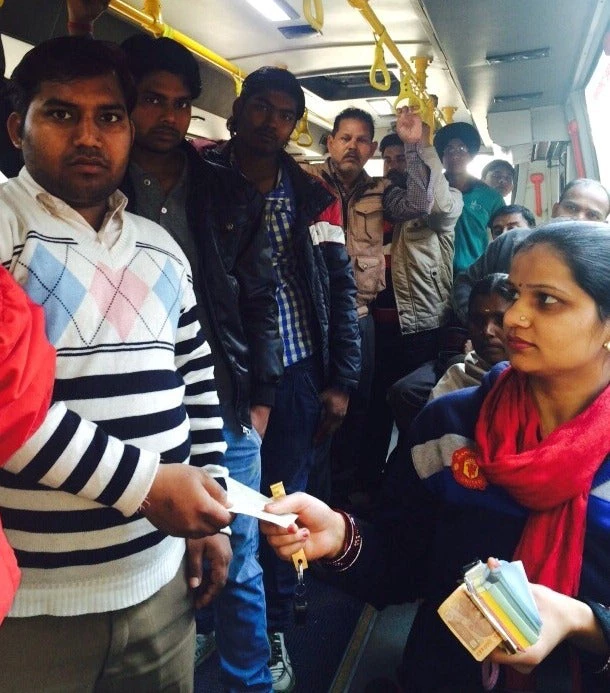If you thought Indian women would shy away from working in that traditionally male preserve - the formidable public transport system - think again. Young women in Chandigarh are daring to turn stereotypes on their head by signing up in large numbers to work as bus conductors! And that too on regular public buses, not just on female-only ‘ladies specials’.

Delhi too is catching up. Its 50 female bus conductors - most operating on four major routes - are already getting a thumbs up from travellers.
Not surprisingly, it was in Chandigarh - where some remarkable social and cultural transitions are taking shape – that the women blazed the trail.
In 2013, when city transport authorities decided to recruit women bus conductors – an undoubtedly bold move for a rough profession - they were in for a big surprise.
In an overwhelming response, more than 4,000 women applied for some 80 plus conductors’ jobs. And these weren’t just modern young women from urban family backgrounds; many hailed from rural areas and some even came from as far afield as the neighbouring state of Haryana.
After a stiff written test, 72 women were shortlisted, and more than 70 signed up. To keep them safe on the job, the Chandigarh police armed the girls with self-defence training.
Routes were allotted keeping the women’s concerns in mind; for instance, women with young children to look after were given routes closer to home.
Women make a difference
Now, three months later, the impact of these 70 intrepid pioneers is becoming visible, even though they are still a small fraction of the 3,000 strong staff on the authority’s rolls.
The quality of services on the women’s routes has improved. Buses are now more punctual and stop at designated places to pick up and drop off passengers, allowing enough time for the young and elderly to board and alight with ease.
Passengers find the women’s behaviour impeccable; there hasn’t been a single complaint against them for misconduct, in sharp contrast to the often unscrupulous behaviour of their male counterparts.
Interestingly, the women’s presence has started to make a dent on the long-standing driver-conductor nexus that has long worked against the interests of the commuting public, particularly of the comfort and safety of women passengers.
As a result, more people are beginning to use public transport, and fare collections are rising.
Still a way to go
But how easy has it been for these women to buck the trend in such an exclusively male preserve? Have the public at large - as well as their male colleagues – been able to fully accept these women in positions of authority over a mostly male travelling public? And, most importantly, are the women safe in their jobs?
A few weeks back, I boarded a Chandigarh bus that had a woman bus conductor on board. Passengers, both male and female, seemed to be pleasantly surprised and supportive of the women doing these jobs.
However, the ticket-checkers pointed out that most women conductors insisted on working only day-shifts that end at 6 pm. I could sense their obvious reluctance to accommodate the women’s demands. They also said that the women lacked the confidence to accost those travelling without a ticket. Nevertheless, I am positive that with time, the system will adapt to the women’s needs.
Still, more can be done to make the workplace more welcoming. Bus stops and depots need to be properly lit, and CCTV cameras installed on buses to ensure safety. And, equipping depots with ladies toilets and separate rest areas will go a long way in making the women more comfortable at work. In addition, self–defence training could be scaled up so that more women are capable of protecting themselves and their passengers from harassment.
Next, it is not enough to just open the job space for women; it will be equally important to confer them with benefits such as accommodation closer to their place of work and a drop-off facility when their shifts end at odd hours. The transport authorities could also include women in route planning because men and women have different needs and uses for basic civic amenities.
But, in the end, it needs to be remembered that a bus conductor’s job is never easy – neither for men nor for women. Often salaries are low, the work load is heavy, shifts begin and end at odd times, there is little leave, and employees must spend long hours on their feet while constantly facing the rude behaviour of passengers, some of whom can be quite violent and unruly.
Encouraging more people to use public transport
But, now, with more women breaking into these traditionally male bastions there is new hope. The World Bank’s Efficient and Sustainable City Bus Services Project - that is working to improve city bus services in 4 Indian cities including Chandigarh - also seeks to make these male preserves more women-friendly.
For, more women bus conductors will encourage more people to use public buses, easing congestion on city roads and making the air easier to breathe for all of us. Today, the city of Chandigarh has made a promising start. The time is now ripe to take this bold new step forward!



Join the Conversation